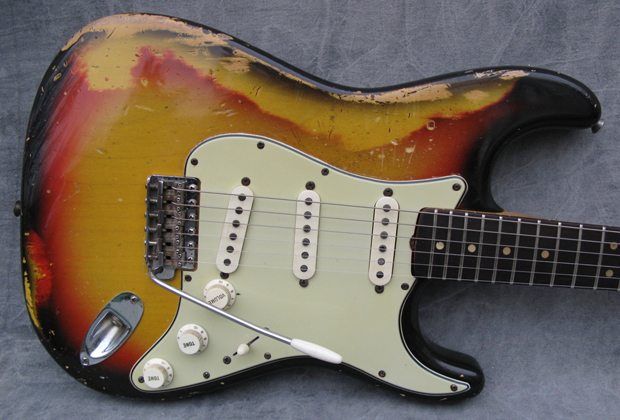Perspectives on Solid-Body Guitar Design

Is anyone else annoyed when someone refers to how conservative the guitar market is?
I am, since in the broader context this is just baloney. Also prompting this post is the comment, “Great, another Strat copy,” in response to a review I did on a Magneto Guitars Sonnet model.
The solid-body electric guitar is still a recent addition on the historical timeline for musical instruments. It continues to evolve in some ways while in others, certain characteristics are already iconic. Still, a guitar player is offered much more variety, at least cosmetically, than, say, a horn player.
Judging from the number of guitar magazines, it may be the most popular instrument of all. How many flute magazines are there? The guitar-playing public has, by far, the most choices in terms of finishes, materials, configurations, shapes and price points. Not to mention the endless peripherals of amps, pedals and accessories.
Guitar brand and model popularity is certainly player-driven. In other words, Gibson continues to sell Les Paul models because people dig Jimmy Page, Slash, Gary Moore, Slash, Zakk Wylde, Slash and Joe Bonamassa — oh yeah, and Slash!
Fender Strats are “sold” by Hendrix, Clapton, Jeff Beck, Robin Trower, Rory Gallagher, Ritchie Blackmore, Stevie Ray Vaughan, Eric Johnson, Kenny Wayne Shepherd and John Mayer. Likewise, Teles, SG’s, V’s, Jazzmasters and 335’s are associated with iconic players. Sorry if I left out your favorites.
This is why people prefer these guitars, as much as the companies themselves may believe they have brilliant marketing staff and ad campaigns.
Get The Pick Newsletter
All the latest guitar news, interviews, lessons, reviews, deals and more, direct to your inbox!
Conservative? That depends on who’s talking. Certainly some builders are frustrated when their own vision of an ergonomic design or a creative and unique shape doesn’t catch on. Also, larger companies competing with Fender and Gibson must work extra hard to position themselves and their instruments for market attention. The most successful of them offer guitars that stick closely to the standard designs, i.e. PRS and EB-Music Man who have pretty stout endorsement rosters of their own — player-driven.
Meanwhile for many more decades or even centuries, clarinets, violas, oboes and various brass instruments remain basically the same cosmetically as they always have. On the other hand, various “classic” electric guitar shapes, which even include the Explorer, Firebird and Flying V profiles, are more than 40 years old. But what more should guitar players want or need?
Just because Leo Fender, Les Paul and Ted McCarty aren’t around right now texting and tweeting doesn’t mean their ideas, designs and methods are obsolete any more than concepts of Thomas Paine and Benjamin Franklin. Between their brilliance, good sense and the number of iconic artists playing their designs, we see a crystallization of the guitar’s profile.
Terms like “retro,” “vintage” and “conservative” with regard to taste, attempt to explain and label market preferences and designs. Contemporary indie artists have revived interest in J-types, not the older couch potatoes who used to play Jags and Jazzmasters. When my kid took me to a Broken Bells & Morning Benders concert, I saw plenty of tweed cabs and a couple old Gretches. Not a conservative crowd there.
So I’m not simply pimping Fender and Gibson here. They are in a fortunate position because of their founders, historical timing and musicians attracted to tried-and-true configurations that their heroes played ... or still play. People aren’t in love with these companies as much as with legendary artists associated with their lines.
Builders like Suhr, DeTemple, Collings, Roukangas, Magneto and dozens more boutique builders continue to refine these platforms in terms of materials and craftsmanship, maintaining strong emphasis on quality and tone. It’s extremely shallow when someone offhandedly refers to their work as “another Strat or Les Paul copy” or labels the market as “conservative.”
Just because the guitar market doesn’t want instruments shaped like Transformers action figures or some mythical battle dragon scrotum doesn’t make most of us conservative. Solid-body electrics are still a modern phenomenon — even the 50-year-old ones ... And feature more variation than most musical instruments.
So don’t accept the “conservative” label! History shows otherwise.
JP Holesworth authors the Stratoblogster Guitar Blog and resides in rural Oregon, surrounded by Pinot Noir vineyards, hop plantations, medical MJ farms and extreme environMENTAL consciousness. But he loves red meat and vacuum tubes!
“I didn’t think anybody would believe I got it from George Harrison. I figured they’d call me a liar”: Vintage guitar guru Norman Harris names the 5 most memorable guitars that have come through Norman's Rare Guitars
“What blew me away was that everyone wanted the curly maple top. People were calling, saying, ‘I’ve got to have the bird inlays’”: Paul Reed Smith on raising the Standard 24, finally cracking the noise-free guitar and why John Sykes is a tone hero










